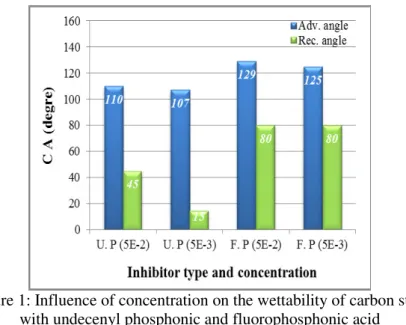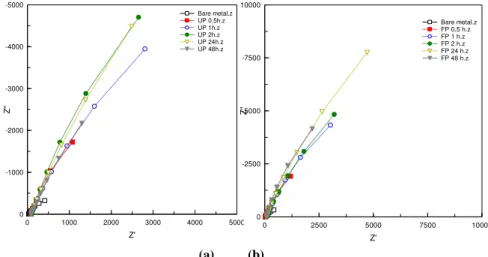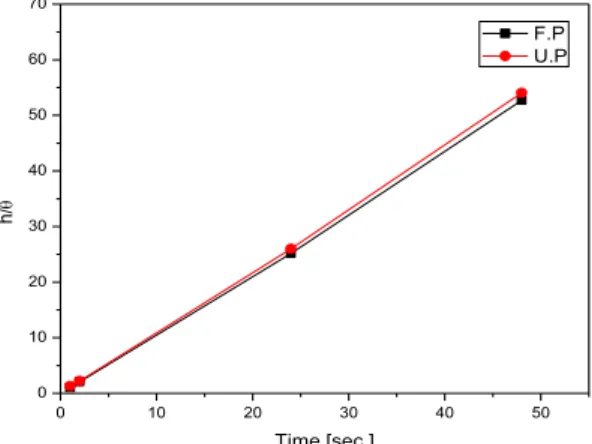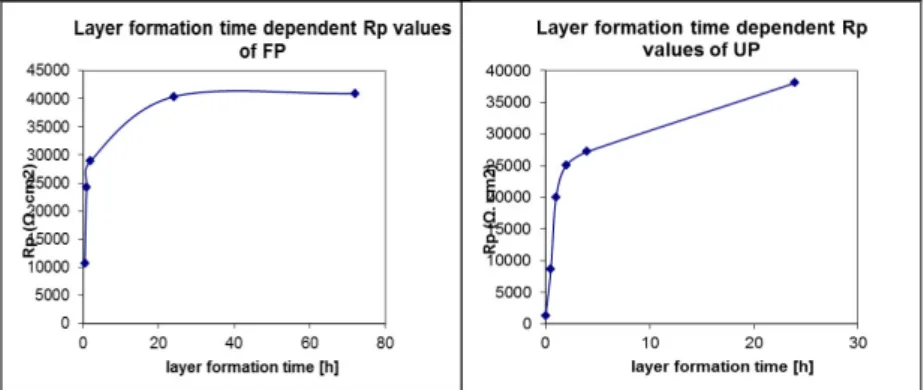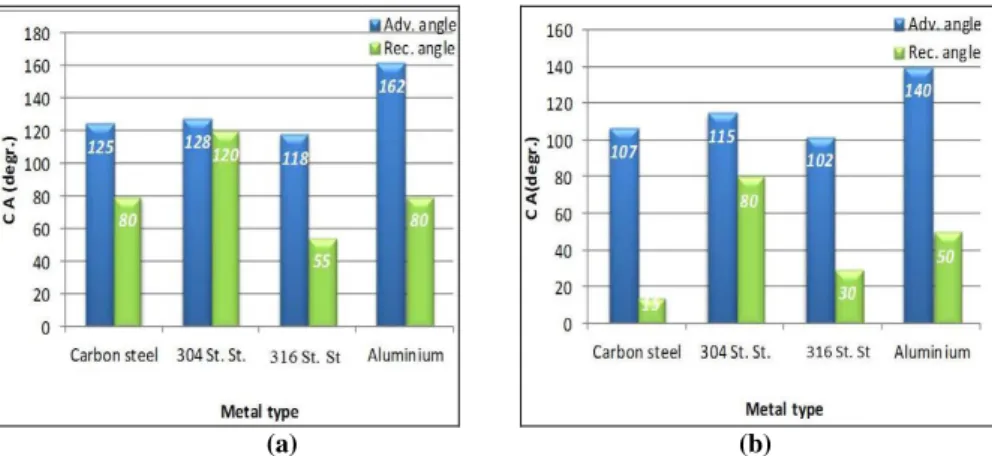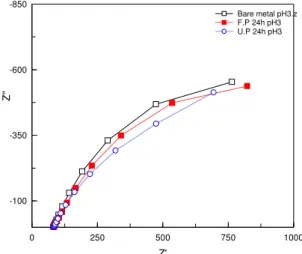Óbuda University
Material Science and Technology PhD School Faculty of Light Industry and Environmental Engineering
Nano-layers against material deterioration in aqueous environment
Talah Abohalkuma
Supervisor: Dr. Judit Telegdi
Budapest 2018
1. Introduction
Metal corrosion is an important expense in all countries budget every year. Its efficient control needs a lot of academic and industrial research; especially because of the most effective inhibitor used – chromate – was banned since the last decade.
Among the enormous number of chemicals used as corrosion inhibitors in case of different metals, the phosphonic acids both in dissolved form as well as in molecular layers can very effectively inhibit the metal corrosion.
SAM layers are monolayers of organic molecules in ordered molecular assemblies on a metal that would modify the solid surfaces by spontaneous adsorption of the head groups. This methodology is a versatile route for surface modification. The change in the tail group of the molecules in the SAM nanolayers results in different surface properties.
The first part of my work focused on the research of preparation of well-ordered self-assembled molecular (SAM) layers formed by two special phosphonic acids, fluorophosphonic acid and undecenyl phosphonic acid. Both are amphiphiles that consist of a -P(O)(OH)2 head group (the geometry of the hydrophilic head group is nearly tetrahedral, and can act both as a hydrogen-bond donor via the two P-OH groups
and a hydrogen-bond acceptor through the P=O oxygen), which can bind only to an oxide layer of the metal surface, and a hydrophobic side chain. They bond via different forces (hydrogen bond, van der Waals force, etc). The difference in these amphiphilic molecules are in the hydrophobic molecular part. Undecenyl nanolayer has an alkenyl side chain with a double bond at the end position which could disturb the formation of a compact SAM layer. fluorophosphonic acid with a semi-fluorinated alkyl phosphonic acid with several fluorine atoms along the carbon chain. It is well-known that the fluorine increases the hydrophobicity of a molecule.
The SAM nanolayers were deposited on carbon steel, stainless steel (304 and 316), and aluminum alloy surfaces. The effects of different parameters such as the layer formation time, amphiphile concentration, surface roughness, stability of SAM in the electrolyte, pH change of the electrolyte, and post-treatment of the undecenyl nanolayer via UV light and γ-irradiation on the quality of the SAM layers were studied by specific techniques.
The used techniques were: contact angle measurements (static and dynamic), atomic force microscopy (AFM), and electrochemical techniques (potentiodynamic polarization and electrochemical impedance spectroscopy (EIS)).
2. Aim of work
The goal of my research was to produce modified metal surfaces that can control different types of metal corrosion. The complex investigation of self-assembled molecular layers, formed by the two amphiphiles makes up the main line of the dissertation. Some other amphiphilic molecules were also investigated for comparison.
3. Applications
The study of these SAM layers formed from both phosphonic acids could be contributed in future to be used in different fields (e.g in electronic industry) as they can control the corrosion in molecular layer thickness (which eventuate the diminution of materials applied against corrosion) in the presence of water in a liquid or vapor form.
4. Methods of study
4.1. Contact angle
In surface science the understanding of the wetting phenomena is a critical subject (79). Studies of the wettability include the contact angle values as basic data. Its definition is the
angle formed at the interface of the solid-liquid and the vapor- liquid (2). If the contact angle (ɵ) value in water is < 90o, then the surface is hydrophilic, while at values of
ɵ
> 90o thewettability in water becomes very low and the surface is hydrophobic (3). There were two types of contact angle measurements applied in this study. First the Static contact angle: a camera takes the drop profile photograph as the sessile drop relaxes and the measurements are achieved by measuring the angle between the tangent of the liquid/solid interface at the three phase contact line and the baseline of the droplet of a defined liquid on the solid surface. This is known as the macroscopic contact angle (2). Second the dynamic contact angle values measured by Wilhelmy balance: The surface tension of a liquid by a Wilhelmy plate apparatus is represented by the force of the liquid pulling down on a plate and measures the contact angle between the plate and the liquid force change detected on the balance is the buoyancy and the wetting force where the force of gravity remains the same (2, 3). When a vertically suspended plate touches a liquid surface, then a force (F) acts on this plate, that correlates with the surface tension and with the contact angle (θ) according to the following
equation: σ = F/L . cos θ, where σ is the liquid surface tension, L is the perimeter of the probe.
4.2. Atomic force microscope (AFM )
This technique allows the surface visualization in 2D and 3D, as well as the section analysis gives numerical information about the surface irregularity and by the roughness parameters the solid surface could also be characterized. it is applicable in a wide range of sciences (materials science, chemistry, physics, and biology) (4). In the case of AFM the force between a very sharp tip and the solid surface under investigation is recorded.
The important parts of the AFM are as follows: a spring (cantilever) equipped with a tip, a piezo tube, a laser beam that illuminates the cantilever from where the laser light will be reflected (through a mirror) into a position sensitive photodetector. The heart of the AFM is the cantilever-tip assembly that interacts with the sample in a raster scanning mode either in a non-contact mode (attractive force range), a contact mode (repulsive force range), or in a tapping mode when the tip constantly changes its position between the two modes.
4.3. Electrochemical Methods
Corrosion phenomena in aqueous environments being of an electrochemical nature and controlled by the corrosion potential of the metal, which makes the electrochemical methods have an important impact on corrosion testing and research (6). Several techniques have been developed throughout the years in the determination of corrosion, such as potentiodynamic polarization and electrochemical impedance spectroscopy (EIS).
4.3.1. Potentiodynamic technique
In this technique, the electrode is submitted to a potential, and the outcome current is measured. At the measurement setup, the scan rate has to be carefully chosen in order to obtain full information taking place on the electrode surface; thus relatively slow potential of e.g. 0.1mV/sec is preferable where at high potential less information can be obtained on the rate establishing step of the working electrode process and information on the fast reaction step. The plotting of the potential (V) vs. the current density (A/cm2) results in the Tafel plots. The current density values are plotted in logarithmic scale.
It presents a significant amount of information such as corrosion kinetics (corrosion potential (Ecorr) and the current density (icorr)), corrosion rate, pitting, passivity, type of the electrochemical reaction (cathodic (reduction) or an anodic (oxidation) reaction). It has also been used for the evaluation of self-assembled monolayers (SAM) formed e.g. by hydroxamic acids on carbon steel (6).
4.3.2. Electrochemical impedance spectroscopy (EIS) It is a non-destructive method (advantages over the DC methods) since it uses very small excitation potential amplitudes and has a minimal perturbation to the working system.
EIS measurements on organic coatings apply alternating voltage over a counter electrode and the coated metal substrate, and the response of the system is registered. Impedance (Z) is a measure of a circuit’s tendency to resist (impede) the flow of an alternating electrical current and is the AC equivalent of electrical resistance (R) in DC applications. The results are shown in forms of: 1. Nyquist plot: where the real vs. imaginary amplitudes of the polarization resistance are shown; this is the representation of transfer functions which are particularly useful for stability analysis in a system; 2. Bode graphs: with the same
data the logarithm of the modulus of the impedance where log
|Z| vs. log ω is the Bode module plot and the phase angle (ϴ) vs.
log ω is the Bode phase plot. The analysis of the impedance spectrum results are in the form of an equivalent circuit models
5. Results and discussion
5.1. Influence of concentration on SAM layers
In case of the undecenyl phosphonic acid layers the increase in the amphiphile concentration from 5 x10-3M to 5 x10-2Mresulted in a better surface coverage, i.e. high advancing and receding contact angle (CA) values were measured for the SAM deposited at 24h and the difference between these values (advancing and receding) decreased. As the flourophosphonic acid formed the SAM layer, almost no change in the CA values was noticed at higher amphiphilic molecule concentration, i.e. 5x10-3M and it was already an optimum concentration giving a value of 125o (Figure 1). Neither the advancing nor the receding CA values were influenced by the higher amphiphile concentration.
Figure 1: Influence of concentration on the wettability of carbon steel with undecenyl phosphonic and fluorophosphonic acid
layers formed at 24h.
5.2. Influence of layer formation time:
The longer the layer formation time the more hydrophobic the coated surface became. Although from the head group’s point of view, they are the same in both amphiphiles. With the increase in the layer formation time, more phosphonic groups attach to the solid, thus less free spaces on the surface for the hydrophobic molecular parts that enables an increased interaction among the hydrophobic chains. This observation was recorded by CA values for both amphiphiles. The hydrophobicity of the metal surface coated by fluorophosphonic acid at shorter time is higher
than in the case of the undecenyl phospohonic acid nanolayer formed at the same time. The interactions between the alkenyl chains and the fluoroalkyl chains are very different as the double bond in the undecenyl part does not allow a strong interaction unlike in case of the fluorophosphonic alkyl chains. This results in adhesion of more phosphonic groups of fluoro compound. The most hydrophobic layers were those formed at 24h in both cases.
This observation was recorded by contact angle, EIS (Figure 2) results and potentiodynamic polarization results (Figure 3).
0 1000 2000 3000 4000 5000
-5000
-4000
-3000
-2000
-1000
0
Z'
Z''
Bare metal.z UP 0.5h.z UP 1h.z UP 2h.z UP 24h.z UP 48h.z
0 2500 5000 7500 10000
-10000
-7500
-5000
-2500
0
Z'
Z''
Bare metal.z FP 0.5 h.z FP 1 h.z FP 2 h.z FP 24 h.z FP 48 h.z
(a) (b)
Figure 2: Nyquist plots for SAM layer formation time dependent;
a: fluorophosphonic acid and b: undecenyl phosphonic acid.
11
(a)
(b)
Figure 3: Effect of SAM layer formation time on the corrosion reactions in the case of; a: fluorophosphonic acid; b: undecenyl
phosphonic acid.
12
A Langmuir-type correlation was found between the layer formation time and the surface coverage (Ɵ) calculated from the efficiencies; in this case not the concentration but the layer formation time correlated with the time/coverage (h/ Ɵ) values.
With this application, a straight line resulted (Figure 4) and not only in the early period of the adsorption but at the longer layer formation time as well.
The efficiency values calculated for both amphiphiles showed that to form a compact layer by fluorophosphonic acid needed a shorter time than the undecenyl amphiphile. The behavior is similar to those results achieved with the potentiodynamic method (Figure 5).
0 10 20 30 40 50
0 10 20 30 40 50 60 70
h/
Time [sec.]
F.P U.P
Figure 4: Correlation between the SAM layer formation time (h) of fluorophosphonic acid and undecenyl phosphonic acid and the h/Ɵ
values.
13
Figure 5: Correlation between the polarization resistance and the layer formation time measured on fluorophosphonic acid and undecenyl
phosphonic acid SAM coated carbon steel.
5.3. Influence of metals type on the SAM layers
SAM layers of both amphiphiles applied on carbon steel, stainless steel 304, stainless steel 316, and aluminum surfaces formed very hydrophobic films (Figure 6). It is important to underline that very compact nanolayer was formed on the stainless steel 304 by the fluoro amphiphile, which is reflected not only in the high advancing but also in the receding CA values as illustrated in Figure 6. The most hydrophobic so-called superhydrophobic nanolayers were formed on aluminum by flourophosphonic acid (CA: 162o).
14
(a) (b)
Figure 6: Wettabilities measured on different metal surfaces covered by amphiphiles; a: fluorophosphonic acid-SAM layer; b: undecenyl
phosphonic acid-SAM layer (5x10-3 M, at 24h).
5.4. Influence of surface roughness
As the roughness increases the surface area increases, more amphiphilic molecules can be bound to the surface through adhesion of head groups but a rougher surface can inhibit the formation of a more ordered structure. This is reflected in the results presented by experiments on SAM formation by the two amphiphiles on aluminum surface (Figure 7) In case of the bare metal showed that at rougher surface the wettability in water decreases as the surface irregularity favors the involvement of air bubbles between the solid surface and the water. It is interesting that the influence of the fluorophosphonic amphiphile (which generally produces more hydrophobic surface than the undecenyl) on the hydrophobicity showed only on smoother
15
surface which differed from the undecenyl phosphonic acid.
70
80
72
95
90
110
88
95
105
128 128 130
110
120
110
118 120 122
0 20 40 60 80 100 120 140 160
400gr 600gr 800gr 1200gr 2000gr 4000gr
C. A (degr.)
Roughness
Bare metal Fluorophosphonic acid Und phosphonic acid
Figure 7: Influence of aluminum surface finishing on the contact angle values with and without SAM layers of fluorophosphonic and
undecenyl phosphonic acids (5x10-3 M; 24 h; gr: grain size)
5.5. Anticorrosion activity of the SAM nanolayers
Two types of corrosion were tested: general and pitting corrosion.
i. SAM nanolayers against pitting corrosion
The carbon steel surface coated with fluorophosphonic acid SAM layer after one hour immersion into NaCl solution showed no sign of pitting corrosion where the SAM layer performed as a
16
good and a dense barrier between the metal and the solution.
SAM layer of fluorophosphonic acid on aluminum surface behaved similarly. The undecenyl phosphonic acid SAM layer on carbon steel surface could not protect the metal surface from pitting corrosion (Figure 8). This is due to the nanolayer structure, which is negatively influenced by the double bond in the molecules which allowed the penetration of the Cl- ion to the metal surface. The post treatment of undecenyl phosphonic acid SAM layer formed on carbon steel with 2 kGy and 20 kGy improved the anticorrosion properties and prevented the formation of pits.
Figure 8: Undecenyl phosphonic acid layer on carbon steel, (layer formation time 30 min) after 1 h of immersion in NaCl
Solution.
ii. The SAM nanolayers against general corrosion
Fluorophosphonic acid and undecenyl phosphonic SAM nanolayers on carbon steel and aluminuim metel surfaces showed
17
no sign of general corrosion when submitted to sodium perchloride for 1h.
5.6. Stability of SAM layers in electrolyte
The results showed that the fluoro amphiphile layer was more stable. After 24 h the original polarization resistance decreased almost to the half but even though this value was 17- times higher than that measured on the bare metal without any coating. The undecenyl phosphonic acid in SAM nanolayer was much less active, the permeability of the layer decreased significantly. This big difference in the Rp values observed between those achieved by fluorophosphonic acid layers and those of undecenyl phosphonic acid is related to the structure undecenyl that has a double bond that did not allow the formationof a compact layer thus the electrolyte penetratd to the metal surface.
5.7. Influence of the undecenyl SAM layer post-treatment The undecenyl SAM layer post-treatment 20 kGy and 20 kGy improve converted the layer structure significantly where it improved the anticorrosion properties and the wetabilaty. These changes were due to the structural modification of the layer, i.e.
the double bonds were converted into a polymer net.
18
This was proven by AFM (Figure 9), contact angle measurements and FTIR results.
(a) bare metal
(b) bare metal immersed into NaCl for 1 h
(c) SAM layered (d) layered and immersed into NaCl
(e) SAM layered and irradiated by 2 kGy
(f) : SAM layered, irradiated and immersion into NaCl
(g) SAM layered and irradiated by 20 kGy
(h) : SAM layered, irradiated and immersion into NaCl Figure 9: Carbon steel metal surface with and with out
undecenyl phosphonic acid SAM layers.
19
5.8. Influence of the electrolyte pH change on the stability of SAM layer
The EIS measurements gave similar results as the potentiodynamic technique when the pH of the electrolytes was varied. At low pH the efficiency decreased significantly. This was due to that there is a change in the head group’s structure initialized by the acidic environment. Increasing the pH to the neutral and alkali range increased the efficacy (Figure 10). The positive effect at neutral pH could be explained by complex effects. One factor that can influence the layer stability is the pK2 value and the other is the solubility of the amphiphiles in alkali environment at higher pHs.
0 250 500 750 1000
-850
-600
-350
-100
Z'
Z''
Bare metal pH3.z F.P 24h pH3 U.P 24h pH3
Figure 10: Behavior of carbon steel coated and uncoated with SAM layer steel in electrolyte with a pH = 3
20
6. References
i. R.Pericet‐Camara, C. L. Moraila‐Martínez, M. A. Rodríguez‐
Valverde, M. Cabrerizo‐ Vílchez,
https://www.researchgate.net/publication/283413453
ii. Y. Yuan, T. R. Lee, Surface Science Techniques, Springer Series in Surface Sciences 51 (2013) 3-34.
iii. Amer Al-Shareef, P. Neogi, Baojun Bai, Chemical Engineering Science, 9 (2013) 113-117.
iv. Zs. Keresztes, T. Rigó, J. Telegdi, E. Kálmán, Applied Physics, A 72 (2001) S113-S116.
v. John N. Murray, Progress in Organic Coatings, 31 (1997) 375– 391.
vi. Ilona Felhősi, Erika Kálmán, Corrosion Science 47 (2005) P 695–708.
7.
Thesis pointsi. I demonstrated that the time of layer formation had a major influence on the performance of the coated surface and it has a more decisive impact on the nanolayer structure than
the increase in the amphiphile concentration.
(T. Abohalkuma, F. Shawish, J. Telegdi; “Phosphonic acid derivatives in self assembled layers against metal corrosion” , International Journal of Corrosion and Scale Inhibition, 3(3) (2014) 151-159).
21
ii. I have proven by contact angle values as well as by the decreased anticorrosion activity that the double bond in the undecenyl phosphonic acid nanolyer disturbs the SAM layer structure. These amphiphilic molecules in SAM layers were less active than that of the fluorophospohonic amphiphile.
This is due to the less ordered structure in the case of the undecenyl amphiphile. At the same time, the influence of hydrophobic fluorine atoms in the amphiphile on the increased hydrophobicity was demonstrated, which resulted in a very condensed molecular layer that was correlated with the very effective corrosion inhibition. (Talah Abohalkuma, Abdul Shaban, Judit Telegdi “Corrosion Processes Controlled by Phosphonic Acid Nano-layers”, Periodica Polytechnica Chemical Engineering, 60(3) 165-168, (2016) DOI: 10.3311/PPch.8260).
iii. In case of the undecenyl phosphonic acid SAM layer, (which has a less ordered structure and, as a consequence, it can control the corrosion processes with less activity,) I was who first modified the SAM layer by post-treatments (by illumination and irradiation); both types of handlings changed not only the surface wettability (because of the polymerization of the double bonds in the nanolayer), but the anticorrosion efficacy was also significantly increased. In the
22
case of the UV light a longer-time treatment (1 h) could successfully modify the layer structure. As to the irradiation, already 2 kGy of γ-ray altered the structure of the nanofilm that resulted in an increased prevention of the metal surface against the pitting corrosion; a much higher dose (20 kGy) produced already a compact nanolyer that was effective against the general and the pitting corrosion. (J. Telegdi and T. Abohalkuma, “Influence of the nanolayer’ post-treatment on the anticorrosion activity”, International Journal of Corrosion and Scale Inhibition, 7 (3) 352–365 (2018) DOI:
10.17675/2305-6894-2018-7-3-6).
iv. The importance of the oxide layer was demonstrated in my work. It was proven that an increased oxide layer thickness on aluminum adsorbs the phosphonic acid amphiphiles more effectively than a thinner one like in the case of the carbon steel oxide layer. On the other hand, I have shown the importance of the alloying elements on the surface characteristics: the different wettability of the two stainless steels (304 and 3016) was confirmed with the differences in the surface oxide layer composition. (Judit Telegdi, Giorgio Luciano, Soumitro Mahantry, Talah Abohalkuma,
“Inhibition of aluminum alloy corrosion in electrolytes by self assembled fluorophosphonic acid molecular layer”,
23
Materials and Corrosion, 67(10) 1027-1033 (2016) DOI:
10.1002/maco.201508304).
v. I proved that the SAM layers formed by fluorophosphonic acid show anticorrosion performance towards both general and pitting corrosion while those formed by undecenyl phosphonic acid are active mainly against the general corrosion. (Tala Abohalkuma, Judit Telegdi “Corrosion protection of carbon steel by special phosphonic acid nano-layers”, Materials and Corrosion, 66(12) 1382-1390 (2015) DOI: 10.1002/maco.201508304).
vi. On the basis of electrochemical results, I have found special correlation between the layer formation time and the anticorrosion activity, which follows Langmuir-type adsorption; in my case, instead of the amphiphile concentration, the layer formation time and the anticorrosion activity is correlated. . (J. Telegdi and T. Abohalkuma,
“Influence of the nanolayer post-treatment on the anticorrosion activity”, International Journal of Corrosion and Scale Inhibition, 7 (3) 352–365 (2018) DOI:
10.17675/2305-6894-2018-7-3-6).
vii. The importance of the environmental pH was demonstrated and explained: the SAM layer formed at 24h by fluorophosphonic acid and by undecenyl phosphonic acid
24
could not keep their anticorrosion activity at pH=3, but these layers are very active at neutral and alkali pH values in inhibiting the metal dissolution. I explained the decreased
efficiency by the change in the head group structure.
(J. Telegdi and T. Abohalkuma, “Influence of the nanolayer post-treatment on the anticorrosion activity”, International Journal of Corrosion and Scale Inhibition, 7 (3) 352–365 (2018) DOI: 10.17675/2305-6894-2018-7-3-6).
7. Publications
i. Journal papers1. T. Abohalkuma, F. Shawish, J. Telegdi “Phosphonic acid derivatives in self assembled layers against metal corrosion” International Journal of Corrosion and Scale Inhibition 3(3) (2014) 151-159.
Cited by:
i. F. Bolzoni, A. Brenna, G. Fumagalli, S. Goidanich, L.
Lazzari, M. Ormellese and MP. Pedeferri, “Experiences on corrosion inhibitors for reinforced concrete”, International Journal of Corrosion and Scale Inhibition, 2014 (3) 254–
278. DOI: 10.17675/2305-6894-2014-3-4-254-278.
ii. Yu.I. Kuznetsov, A.A. Chirkunov, A.S. Gorbachev and N.P.
Andreeva, “Passivation of mild steel by sodium octylphosphonate in neutral aqueous solution” International
25
Journal of Corrosion and Scale Inhibition, 2017 (3) 318–
332, DOI: 10.17675/2305-6894-2014-3-3-151-159.
iii. Yu. I. Kuznetsov, G. V. Red’kina, N. P. Andreev
“Adsorption from Neutral Solutions of Sodium Alkyl Phosphonates on Zinc and its Passivation”, Russian Journal of Physical Chemistry A, 2018, 92 (12) 2548–2555.
iv. Yu. I. Kuznetsov, A. M. Semiletov, A. A. Chirkunov, I. A.
Arkhipushkin, L. P. Kazanskii, N. P. Andreeva, “Protecting Aluminum from Atmospheric Corrosion via Surface Hydrophobization with Stearic Acid and Trialkoxysilanes”, Russian Journal of Physical Chemistry A, 2018, 92 (4) 621–
629.
2. Tala Abohalkuma, Judit Telegdi “Corrosion protection of carbon steel by special phosphonic acid nano-layers”
Materials and Corrosion, 66(12) 1382-1390 (2015) DOI:
10.1002/maco.201508304. IF: 1.37
Cited by:
i. M. Yuan, I. Tanabe, Jean-Marie Bernard-Schaaf a, Q-Y. Shi, V.
Schlegel, R. Schurhammer, P. A. Dowben, B. Doudin, L.
Routaboul, and P. Braunstein, “Influence of steric hindrance on the molecular packing and the anchoring of quinonoid zwitterions on gold surfaces”, New Journal of Chemistry, 2016 (40) 5782- 5796 , DOI: 10.1039/C5NJ03251B.
ii. Y. Huang,Y. Xu,B. Li,L. Ying,F. Yang &X. Wang, “Novel electrical resistance method to measure underdeposit corrosion and its inhibition in pipeline steels”, Corrosion Engineering , Science and Technology, The Internatial iii.
26
Jornal of Corrosion Processes and Corrosion Control, 2016 (51) 211- 222, DOI.org/10.1179/1743278215Y.0000000047.
iv. F Bolzoni, A Brenna, G Fumagalli, S Goidanich,
“Experienceon corrosion inhibitors for reinforced concrete” International Journal of Corrosion and Scale Inhibition, February 13, 2017. DOI: 10.17675/2305-6894-2017-6-1-5.
Int. J.
v. Charlotte M. Sevrain, Mathieu Berchel, Hélène Couthon, Paul-Alain Jaffrès, “Phosphonic acid: preparation and applications”; Beilstein Journal of Organic Chemistry, 2017 (13) 2186–2213. DOI:10.3762/bjoc.13.219.
vi. Valbonë V. Mehmeti and Avni R. Berisha “Aqueous Sulfuric Acid Solution Using 4-Methyl-4H-1,2,4 Triazole-3-Thiol and 2-Mercaptonicotinic Acid—An Experimental and Theoretical Study” Frontier in Chemistry, DOI:
10.3389/fchem.2017.00061.
vii. V. Mehmeti, K. Kalcher, F. Podvorica, A. Berisha,
“Corrosion Inhibition of Mild Steel in Aqueous Sulfuric Acid Solution Using Heterocyclic Mercapto Compounds- an Experimental and Theoretical Study”, Radiation and Applications, rad-journal.org, 2017 (2) 41–45, DOI:
10.21175/RadJ.2017.01.009.
3. Talah Abohalkuma, Abdul Shaban, Judit Telegdi
“Corrosion Processes Controlled by Phosphonic Acid Nano-layers” Periodica Polytechnica Chemical Engineering, 60 (3) 165-168, (2016) DOI:
10.3311/PPch.8260. IF: 0,13
27
4. Judit Telegdi, Giorgio Luciano, Soumitro Mahantry, Talah Abohalkuma, “Inhibition of aluminum alloy corrosion in electrolytes by self assembled fluorophosphonic acid molecular layer” Materials and Corrosion, 67(10) 1027- 1033 (2016) DOI: 10.1002/maco.201508304. IF: 1.4
Cited by:
i. Yu. I. Kuznetsov, “Organic corrosion inhibitors: Where are we now? A review. Part IV. Passivation and the role of mono- and diphosphonates” International Journal of Corrosion and Scale Inhibition, 2017, 6, 4, 384- 427, DOI: 10.17675 / 2305-6894-2017-6-4-3.
ii. B. Arrotin, J. Delhalle, P. Dubois, L. Mespouille, and Z.
Mekhalif, “Electroassisted Functionalization of Nitinol Surface, a Powerful Strategy for Polymer Coating through Controlled Radical Surface Initiation”, Langmuir, 2017, 33 (12), 2977–2985, DOI: 10.1021/acs.langmuir.6b04536.
iii. F. Yang, X. Li, S. Qiu, W. Zheng, H. Zhao2, L. Wang,
“Water Soluble Trianiline Containing Polyurethane (TAPU) as an Efficient Corrosion Inhibitor for Mild Steel”, International Journal of Electrochemical Science, 2017 (12) 5349 – 5362, DOI: 10.20964/2017.06.53.
iv. F. Yang, X. Li, Z. Dai, T. Liu, W. Zheng, H. Zhao, L. Wang,
“Corrosion Inhibition of Polydopamine Nanoparticles on Mild Steel in Hydrochloric Acid Solution”, International Journal of Electrochemical Science, 2017 (12) 7469 – 7480, DOI: 10.20964/2017.08.52.
28
5. J. Telegdi and T. Abohalkuma, “Influence of the nanolayer’post-treatment on the anticorrosion activity”, International Journal of Corrosion and Scale Inhibition, 7 (3) 352–365 (2018) DOI: 10.17675/2305-6894-2018-7-3-6.
ii. Conference publication:
Oral presentations:
1. T. Abohalkuma, Ahlam BenHamed, Evaluation of four different corrosion inhibitors on mild steel used in cooling systems”, 6th International conference on Technology of Oil and Gas (TOG 2012) , 16 − 18 October 2012, Tripoli, Libya.
2. Talah Abohalkuma, Judit Telegdi “Micro and nano- layers against material deterioration in aggressive ions environment” COST Action FP 1003: Impact of renewable materials in packaging for sustainability – Development of renewable fibre and bio-based materials for new packaging applications, 24 – 27 September 2013, Budapest- Hungary.
3. T. Abohalkuma and J. Telegdi “Protection of mild steel against corrosion by flourophosphonic acid and undecenynel phosphonic acid nanolayers”, 14th Conference Day of PhD Students, Veszprém, Hungary, 24th November 2014.
4. Talah Abohalkuma, Judit Telegdi “Corrosion processes controlled by phosphonic acid nano-layers”, Veszprém, Hungary, April 2015.
29
5. T. Abohalkuma, J. Telegdi, G. Lucian, A. Shaban “Surface treatment with unusual phosphonic acids”, 7th Kurt- Schwabe-Symposium, University of Applied Science Mittweida/Germany, 4 – 7 September 2016.
6. Telegdi Judit, Tala Abohalkuma, Shaban Abdul “Hogyan befolyásolja az önszerveződött amfifil molekulák szerkezete a nanorétegek viselkedését?” MTA TTK AKI, Funkcionális Határfelületek Kutatócsoport, Intézeti Szeminárium, Budapest, Hungary, 14th February 2017.
7. Talah Abohalkuma, Abdul Shaban, Judit Telegdi,
“Corrosion control by self-assembled nanolayer coatings”
Functional coatings ETCC-303, Amsterdam, The Netherlands, 26- 29 June 2018.
8. Six presentations at the end of each of the first six semesters.
Poster presentations:
1. T. Abohalkuma “Effect of Galvanic Coupling of Metals on Efficiency of Inhibitors in Cooling Systems”
EUROCORR 2012, 9-13 September, Istanbul- Turkey.
2. T. Abohalkuma and J. Telegdi “Comparative Analysis of Chemicals Used in Dissolved Form and in Nano-Layer” at the International joint conference on environment and light industry technologies, 21 −22- 2012 November, Budapest- Hungary.
30
3. T. Abohalkuma and J. Telegdi “Micro and nanolayers against material deterioration in aggressive ions environment” Conference of Chemical Engineering days 2013, April 23 − 25, Veszprém, Hungary.
4. T. Abohalkuma and J. Telegdi “Special phosphonic acids used in nanolayers against corrosion” at the EUROCORR 2013 September 1 - 5, 2013, Estoril, Portugal.
5. T. Abohalkuma, Judit Telegdi “Phosphonic acid derivatives used in self assembled layers against metal corrosion” at the International Joint Conference on
Environmental and Light Industry Technologies 20 – 22 November 2013, Budapest, Hungary.
iii. Previous publication:
1. W. Benziglam, T. Abokalkuma N. Alahrish, F. Elshawish,
“Role of Steel Surface Finish on the Performance of Sodium Nitrite Inhibitor” EUROCORR 2003, 29 Sep.-2 Oct. 2003, Budapest- Hungary.
2. F. Elshawish, W. Benziglam, T. Abokalkuma, N. Alahrish,
“Effect of Chloride and Sulfate Ions on the Performance of Sodium Nitrite Inhibitor”, EUROCORR 2003, 29 Sep.-2 Oct. 2003, Budapest- Hungary.
3. A. Elhod, T. Abokalkuma, W. Benziglam, N. Alahrish, F.
Elshawish “Effect of Chloride Ions on the Performance of Sodium Nitrite Inhibitor” Problems of Corrosion and
31
Corrosion Protection of Materials, 8-10 June 2004, Lviv Ukraine.
4. T. Abokalkuma, A. Elhod, “Failure Analysis of a Cast Iron Track Wheel”, Fracture Mechanics of Materials and Structural Integrity, June 22-26, 2004, Lviv, Ukraine.
5. T. Abokalkuma, N. Alahrish, F. Elshawish, “Effect of pH on the Performance of Sodium Nitrite Corrosion Inhibitor”, EUROCORR 2004, 12-16 September 2004, Nice- France.
6. W. Benziglam, T. Abokalkuma, N. Alahrish, F. Elshawish
“Effect of Flow Rate on the Perfomance of Sodium Nitrite Inhibitor”, EFC Workshop, 27-29 October 2004, Frankfurt, Germany.
7. T. Abokalkuma, N. Alahrish, F. Elshawish “The Performance of zinc- phosphonate Corrosion Inhibitor under Different Conditions of Concentration, Temperature and Aggressive Ions”, SCIENCE &
ECONOMY NEW CHALLENGES, 8th – 10th JUNE 2005, Warsaw – Poland.
8. F. Elshawish, T. Abokalkuma, N. Alahrish, “The Role of Dynamic Flow on the Performance of Zinc- Phosphonate as a Corrosion Inhibitor”, Corrosion Control for Sustainable Development (EUROCORR 2005), 4-8 September 2005, Lisbon, Portugal.
32
9. F. Elshawish, T. Abokalkuma, N. Alahrish, “Zinc chromate as effective inhibitor for industrial cooling water system” Corrosion Control for Sustainable Development (EUROCORR 2005),4-8 September 2005, Lisbon, Portugal.
10.T. Abokalkuma, N. Alahrish, F. Elshawish, “Performance of Zinc–Phosphonate Corrosion Inhibitor under Different Conditions of Calcium Concentration, and Aggressive Ions” TOG, 2006, Tripoli, Libya.
11.T. Abokalkuma, N. Alahrish, F. Elshawish “Assessment of Zinc-1 Hydroxyethylidene-1, 1- Diphosphonic Acid (HEDP) as Corrosion Inhibitor for Mild Steel” First international conference on functional nanocoatings, 30-3 to 2-4- 2008, Budapest, Hungary.
12.T. Abokalkuma, N. Alahrish, F. Elshawish “Synergetic Effect of Corrosion Inhibitor for production of mild steel Used in Cooling Water system” EUROCORR 2008, 7- 11 September 2008, Edinburgh, UK.
13.T. Abokalkuma, F. Elshawish, “Performances of three different corrosion inhibitors used in industrial cooling water systems” EFC Workshop 2009, September 30 - October 2 2009, Frankfurt, Germany.
14. T. Abokalkuma “Effect of Galvanic Coupling of Metals on Efficiency of Inhibitors in Cooling Systems” NANOCOATINGA- International conference on nanocoatings 20-31 March 2010, Dresden, Germany.
